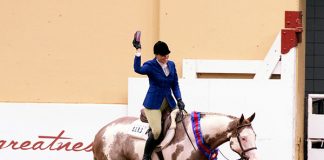Q: I’m teaching my horse the barrel pattern, but I can’t keep him in a lope. How do I fix this?

Many riders position the barrel up by their horse’s shoulder, and they’ll pull his nose too much and hold it without realizing that they’re keeping constant pressure on him. The horse is physically unable to maintain his gait without knocking a barrel, so if he’s not already trained and hasn’t figured out some way to cheat his body around the barrel—by either swinging his butt out or taking an extra step—the barrel becomes an obstacle. He can’t maintain the lope because of improper body position in relation to the barrel, so he breaks gait.
If you position the barrel behind your leg or at the back cinch, then the barrel won’t be in the way and your horse’s forward momentum won’t be affected by it.
To improve performance at the lope, go back to the walk and trot and be sure you’re positioning the barrel properly. Go around the barrel two or three times. At the walk and trot, your horse should be able to comfortably keep his balance on his back end. With the barrel positioned properly and a slight arc in his body, he can easily go around that turn multiple times. The extra circles need to be perfectly round and an equal distance from the barrel (about 3 feet for the walk and trot).
If turning too soon is the problem, trot up and stop with the barrel beside your leg, kick the horse’s hip back under him, and then walk a couple of perfect circles around the barrel. Next time, trot up, stop, walk a perfect circle, trot a couple of perfect circles, and then go to the next barrel.
Remember that if you’re not sitting deep as you go into the turn, you’re putting your horse on his front end to start the turn, which kills his forward momentum. If you sit down on your pockets as your horse approaches the barrel and goes around it, then you’re helping him balance on his back end. He won’t lose his inside hind leg, which is the driving leg that powers him up and around the turn.
Read more on barrel racing and speed events >>
This article originally appeared in the January 2014 issue of Horse Illustrated magazine. Click here to subscribe!






